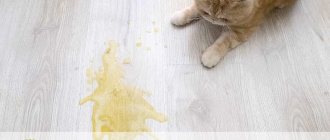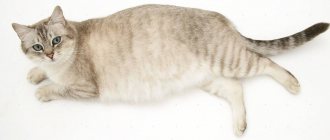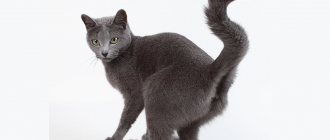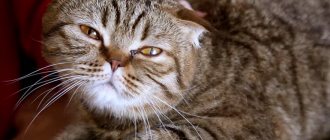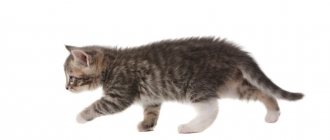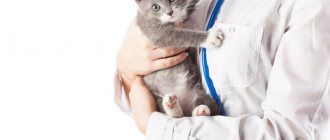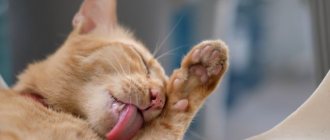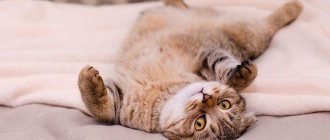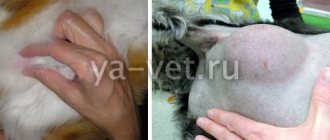11559Administration
4
Vomit with green discharge indicates that a large amount of bile and intestinal secretions have accumulated in the stomach. This is the so-called cleansing vomiting, which helps rid the body of excess. But green vomit in a cat can be a harbinger of a dangerous infection.
You can determine the risks for your pet by studying the causes that influence the occurrence of nausea.
© shutterstock
The following factors can lead to green vomit and cause nausea::
- Infection . Poor quality food or expired products often cause dangerous infections in the body. Therefore, most street cats suffer from weight loss: parasites destroy a weakened body.
- Poisoning . A cat can become poisoned from food or medications. Bile mass is the body’s reaction to toxins and other harmful substances that the stomach throws out through nausea.
- Intestinal problems . The problem is more difficult if vomiting does not stop for a long time. This may be a sign of a blockage in the intestinal tract. Therefore, if there is active nausea with green discharge, foam and blood, it is better to show it to a veterinarian.
- Diseases . Cats suffer from chronic illnesses. These are problems with the bladder, ulcers, cancerous tumors. For a sick animal, yellow vomit is a common practice. If there are brown spots, the result is almost one hundred percent - an ulcer.
The main causes of vomiting
Vomiting has different causes, on which treatment depends. If the cat’s vomiting is yellow, the urge does not recur and, in general, the cat feels fine, then most likely the malaise was caused by one of the following factors:
- Stress or fear. A change of scenery, the appearance of a child or a new animal in the house, a long absence of the owner - isn’t this a reason to be nervous?
- Binge eating. Representatives of the cat family cannot always control their appetite; cats vomit after eating, usually for this reason. Especially when some kind of delicacy was offered for lunch.
- Pregnancy. Not only women suffer from toxicosis. When preparing to become a mother, a cat may well behave unnaturally.
- Ingestion of hairballs. These noble cleaners often swallow wool during the grooming process and then get rid of it.
- Disorders of the vestibular apparatus. Often happens after traveling in a car.
But in some cases, nausea may indicate a serious illness, when you should definitely consult a veterinarian:
- Poisoning. Did your pet eat something on the street or did you decide to try a new culinary experiment? Start treatment immediately, and after 2-3 days the cat’s condition will return to normal.
- Inflammatory processes in the throat. They can be caused by both infection and ingestion of sharp objects.
- Worms. Unpleasant, but not fatal. A few days of taking the pills and everything will pass.
- Kidney or liver disease. This is a more serious problem, but there is no need to panic.
- Diabetes. Did you not know that cats are also susceptible to this disease?
- Intestinal obstruction, volvulus. See a doctor urgently!
Circumstances under which vomiting occurs
It is also important to pay attention to what preceded the problematic situation and how your pet is feeling overall. Often it also gets worse, but even more often it does not change - and the rest of the time the cat is cheerful and cheerful.
Article continues after advertisement
The cat has diarrhea and vomiting
This situation is similar to an infectious disease, as well as poisoning with chemicals, poisonous plants or poor quality products. In addition, this may be a reaction to individual foods or to an incorrect diet in general.
MORE DETAILS
The cat is constipated and vomiting
If a cat has not gone to the toilet for a long time and is vomiting, this is a sure sign of intestinal blockage. Perhaps a foreign object or fur has gotten in there. Also, the passage could be blocked by helminths. In this case, acting on your own is dangerous. Let's go to the vet clinic!
The cat does not eat and vomits
Refusal to eat, accompanied by vomiting, can also be associated with intestinal obstruction, but often this condition occurs against the background of intoxication, after vaccinations and anesthesia. Depending on the background against which this is happening, you need to either calm down and wait, or go to the veterinary clinic.
The cat is vomiting and lethargic
A similar case to the previous one. It can be observed against the background of obstruction, and against the background of infections, and against the background of poisoning. This often happens when poisoned by insecticides after bathing in anti-flea shampoo.
Cat vomits after eating
Vomiting after eating can be caused by various reasons - from overeating to diseases of the internal organs.
MORE DETAILS
Cat vomits on an empty stomach
Vomiting on an empty stomach, when there is a significant break between meals, is not a terrible phenomenon, but it can be corrected. It is caused by the fact that gastric juice irritates the mucous membrane - and the body removes the aggressive substance out.
MORE DETAILS
Chronic periodic vomiting
There are many causes for chronic vomiting. It is necessary to take into account the nuances in order to understand the problem, and in some cases, to deeply examine the animal.
Article continues after advertisement
MORE DETAILS
Vomiting in the morning or at night
Such conditions can also be associated with various reasons, but the most common is hungry vomiting.
MORE DETAILS
Vomiting in a cat after anesthesia
Vomiting in a cat after anesthesia is not uncommon. Owners most often do not see this, because... everything happens in the clinic, but it can also happen at home. If you vomit once after anesthesia, you should not worry. If it continues, then you need to at least take measures against dehydration. Call the veterinarian who performed the surgery and report the problem.
Cat vomits after vaccination
Sometimes a reaction to a vaccine can be like this. This does not yet indicate the onset of life-threatening complications, but the cat’s condition needs to be monitored.
MORE DETAILS
The cat feels nauseous, but does not vomit
Sometimes the urge indicates the need to empty the stomach, for example, from a hairball, but often the fact that the cat is choking, as if vomiting, but is not vomiting, speaks of completely different conditions.
Cat coughs and vomits
Vomiting and coughing are indirectly related. Firstly, the cat may appear to cough before vomiting fur from its stomach. Secondly, diseases that cause coughing can also cause vomiting: the center of vomiting and the cough center in the brain are located nearby. Thirdly, during coughing there is pressure on the esophagus, which can also provoke vomiting. But for this the cough must be strong. Be that as it may, an examination is indicated for the cat.
Vomiting in a cat with cystitis
If this is observed, this indicates intoxication of the body and that the clock is ticking - it is necessary to urgently run to an experienced veterinarian, who must take immediate action. It is advisable that this is your treating veterinarian who already knows the medical history.
Vomiting in a cat after antibiotics
Here it is necessary to distinguish between two situations: when the cat vomits immediately after taking the pill and when he vomits after a whole course of antibiotics, regardless of the medications taken.
Article continues after advertisement
The cat snatched up a deworming tablet
Cats often vomit after taking the pill. There are several reasons: the tablet is too large, an individual reaction to the medicine, or taking the tablet on an empty stomach. If the pill comes back out, it means it didn't work. And vomiting without a pill, but within the next 30 minutes after taking it, also casts doubt on whether the substance has been absorbed in full.
Kitten vomits after bathing
On the one hand, the cause of vomiting in this case may be stress or the fact that the kitten swallowed water. However, vomiting after bathing is often observed when flea control has been used. Moreover, you should know that some unscrupulous manufacturers do not indicate that the composition contains an insecticide (that is, poison), but it is present there. A cat can be poisoned by this poison, just like fleas. The cause could also be an allergy to a completely harmless shampoo. In any case, vomiting after swimming should not be ignored.
The cat vomits all day
If your cat vomits all day long and often, the situation is similar to an infection, poisoning, or an acute phase of pathology of internal organs. In any case, you must seek the help of a veterinarian.
After mating the cat vomits
This may be due to several factors: from stress to infection from the cat.
Pregnant cat vomits
Cats, like women, can experience toxicosis of pregnancy, although its existence is still debated. This sometimes leads to vomiting. However, vomiting can also be a coincidence, because... a pregnant cat can also get an infection, get poisoned, accumulate a hairball in the stomach, etc. Therefore, the condition of the expectant mother needs to be monitored especially closely, and even if it is simple toxicosis, but the vomiting is debilitating or diarrhea has been added, you should definitely consult with her treating veterinarian.
A cat vomits after giving birth or before giving birth
Most often, diarrhea and vomiting after childbirth are associated with eating an excessive amount of afterbirth, which causes gastrointestinal upset. This condition passes quickly. If not, you need to contact your veterinarian. And before giving birth, vomiting may indicate that the process of giving birth to kittens is already approaching and the uterus is now actively contracting.
Vomiting in a cat during heat
Vomiting is not associated with estrus, but may be a reaction to heat control medications. If you haven't given these to your cat, the vomiting is a coincidence and is due to some other reason.
Cat vomiting due to stress
Just like in humans, vomiting and diarrhea in cats can occur due to nervousness. This physiological reaction does not happen very often, but it should not be ignored. First of all, understand the cause of stress and eliminate it if possible. If stress is dictated by some life circumstances that you cannot prevent, and the cat is very stressed, you can use preparations based on an analogue of cat pheromones: by inhaling their scent, the cat will feel safe.
Causes of vomiting in cats
The causes of vomiting in cats vary. Vomiting once in cats is a completely natural phenomenon that occurs as a result of the animal’s periodic need to get rid of the contents of its stomach. For example, in the process of caring for their fur coat, cats lick themselves, which is why they have to swallow this or that amount of hair every day, which settles in their digestive tract. Nature has made sure that animals have the opportunity to independently get rid of the hair accumulated in the stomach. Therefore, cats periodically regurgitate hairballs that are dangerous to their health.
Frequent vomiting in a cat is a symptom, which indicates the development of a pathological process in its body. This condition accompanies almost all viral infections, helminthic infestations, food and pesticide poisoning, diseases of the gastrointestinal tract, liver, pancreas or kidneys. Naturally, such vomiting will always be associated with other pathological manifestations: diarrhea, increased general body temperature, convulsions, pain, apathy, refusal of food, water, and much more. Repeated vomiting in a cat, the treatment of which is carried out taking into account the etiological factor of the underlying disease, requires immediate consultation with a specialist and all necessary examinations.
What to do if your cat is vomiting?
Vomiting in cats, the treatment of which is best left to a professional, is a signal that something is wrong with the animal. Frequent release of vomit is dangerous for the pet with the risk of dehydration, so in this case you should not waste time and take the cat to the veterinarian.
If you suspect food poisoning in a cat, you should stop feeding it for 6-8 hours. Drinking water can be stopped if it does not provoke a new urge to vomit. A positive sign of improvement in your cat's health will be the return of its appetite. But you shouldn’t immediately overload your animal’s digestive system with goodies. It is better to give food little by little, starting with light, ground food, lean meat, rice water, and medicinal feed.
What to feed after vomiting?
In addition to treatment, the cat’s nutrition during this period is also important. The menu must be dietary, and constant monitoring of the well-being of your four-legged friend must be ensured. When yellow vomiting is observed in an animal, the cat should be hungry for the first 10 hours, and instead of drinking, you can give a piece of ice.
Constant nausea can lead to dehydration, so it is extremely important to monitor your pet's water balance. A therapeutic cat diet should not include fatty, salty and spicy foods. It is best to cook light porridges. If the cat is accustomed to dry food, then you need to change it to medicated food. For the first few days it is best to give:
- baby purees;
- rice broth;
- boiled chicken.
Rice decoction is beneficial for an animal after severe vomiting
What to do if your cat vomits from any food?
The first cause of vomiting in a furry friend is unsuitable food. This rarely happens; usually the animal itself refuses to eat this or that food. By smell, these domestic predators determine whether the food is of low quality and whether what is in the bowl is worth eating. If the owner has already tried all the food, but the situation has not changed, then the problem is not in the food. There are two options: the animal simply overate, or got sick. The first option is easier to deal with
To prevent the animal from overeating, it is important to feed a strictly defined amount of food, without exceeding the volume
Animals have almost no feeling of satiety. Cats are no exception; they will eat until their bowl is empty, and then vomit up undigested food and cover it with a rug. If your cat gets sick after eating food, you just need to give her more water and reduce the portion.
As for the second option – disease, things are more complicated. Simply reducing portions will not correct the situation. It is better not to diagnose the animal’s condition yourself, but to consult a veterinarian.
Prevention
Since vomiting is not a disease, but a consequence of a disease, preventive measures should be aimed at the underlying problem. First of all, you need to change the cat's diet. Perhaps the foods your pet eats are poorly digested. This mainly applies to cheap dry food, which is more harmful to the health of the animal. Stagnation in the intestines can be caused by poor nutrition and alternation of different foods. The best option for your pet’s stomach is food from one company.
If the reason is still in the food, then it is better to switch your pet to natural food. Boiled chicken and rabbit, vegetables and cereals quickly normalize the functioning of the pet’s digestive system.
If the cat has long hair and often vomits hairballs, then specialized food for cats with long hair should be included in the diet. You need to feed the cat in small portions, but often. This manipulation will not lead to overeating.
Treatment of vomiting in cats
If your pet has only vomited once and is feeling fine, there is no need to see a doctor. Vomiting does not require any special treatment. However, if vomiting has already occurred more than three times a day and the cat looks depressed and sick, then it is best to show the animal to a specialist and think about what could have caused this condition.
With frequent or prolonged vomiting, there is a risk of dehydration. To combat this, instead of water, you can give your pet Regidron solution or give salted water in the proportion of 9 grams of salt (teaspoon) per 1 liter of water.
In advanced and very severe cases, the cat may refuse to drink water. To save her from dehydration, Ringer's solution must be given by injection.
If vomiting becomes more frequent, you need to give the cat an antiemetic - Torekan, Paspertine, Phenothiazine. It is recommended to feed a sick pet with bismuth preparations.
These are products that protect the mucous membrane from irritation. You can give your pet herbal decoctions: chamomile, flax seed 3-6 times a day.
If the cause of vomiting is poisoning, it is necessary to give the cat activated carbon, which is an excellent adsorbent.
In such conditions, a dropper with ascorbic acid glucose is indicated, which relieves intoxication in the animal’s body.
In cases where it was caused by poisoning or problems with the gastrointestinal tract, it is recommended to put the animal on a special diet for the duration of treatment and in the next few days.
This therapeutic diet consists of simple rules:
- fractional feeding of the animal in small portions;
- the consistency of the food should be puree or soft;
- Start giving your cat meat food gradually.
How to feed correctly?
A pet will not drink vitamins if they are lacking, so all the vitamins and minerals it needs must be present in the food. The animal needs balanced food. How to feed your furry friend correctly, how to make sure that the animal receives with food everything it needs for proper development and good health?
- First, the amount of food should be limited. You need to feed the animal 2-3 times, in the morning and in the evening, but you can skip lunch. Portions should be approximately the same size each time. It is better to put in less food and then add it later, rather than the animal overeating and becoming ill.
- Secondly, the food must be of high quality. High quality does not mean expensive. You can boil the animal’s meat yourself, adding carrots and other vegetables. If you don’t want to cook separately for your cat, then you should contact your veterinarian for advice; he will be able to tell you exactly what food is suitable for a particular breed.
- Thirdly, the water in the bowl must be clean. You need to change and add water at least twice a day, it is better to do this in the morning and evening. Your furry friend should always have water. There is no need to experiment and pour mineral water with gases into your cat. The cat will not drink water, and he will have to sit without water all day, which is fraught with negative consequences for his body.
- Fourthly, a four-legged friend needs grass. You can buy seeds for such grass at any pet store; it is inexpensive, grows quickly, and looks like a lawn. Cats love this simple green grass.
- Fifthly, your pet’s diet must include fish. Fish contains useful microelements that a cat needs as a predator.
- Sixth, if a favorite predator eats what its owner eats (some cats love apples, cucumbers and other foods), there is no need to wean him off. This means that the beneficial substances contained in these products are necessary for the predator.
Creating the right diet for a cat is not difficult. The main thing is to monitor your pet’s well-being, carefully read the composition of the food he eats, listen to the veterinarian’s recommendations and add variety to your pet’s diet.
Vomiting in a cat is a fairly common phenomenon. Periodically, our pets cleanse their stomachs in this way and get rid of discomfort. But sometimes it can be a clear sign of something wrong with the body, such as when your cat vomits yellow liquid. Every loving owner should learn to distinguish a natural urge from one caused by a disease. In most cases, with adequate assistance, the illness goes away quickly and without any consequences.
Variants of vomiting in cats
Vomit in cats differs in color and consistency, which depend on the causative factors of the underlying disease. Variants of vomiting in cats can be as follows:
- Vomiting with white foam. White foam is formed in the stomach when mucus, gastric juice and air mix in the process of mixing them in the stomach. Foamy white vomit indicates that at the time of its release the animal’s stomach was empty, so this phenomenon is regarded by veterinarians as natural. Repeated vomiting of bile juice with mucus, which is characteristic of inflammatory processes in the gastrointestinal tract, should cause concern.
- Vomiting with bile impurities. Normally, there should be no bile in the stomach. Its appearance there indicates reflux, which can occur against the background of various diseases of the liver and gall bladder. As you know, bile is a very aggressive environment, so over time it can provoke reactive gastritis, which will lead to a deterioration in the general condition of the cat.
- Vomit with greens. Green vomit may occur in a cat that has eaten a lot of grass. This condition is not considered dangerous for the pet and does not require specialist advice. It’s another matter when an animal vomits thick masses with dark green impurities, which are nothing more than bile. This is typical for intestinal obstruction, severe pathological processes of the biliary tract and liver, tumors, and the like.
- Vomiting blood in a cat. It can occur in two variants: with an admixture of light, scarlet blood and with dark blood, like coffee grounds. Vomiting with scarlet blood occurs when there is bleeding in the injured canal above the stomach, as well as in the throat and mouth. Coffee grounds form when blood mixes with hydrochloric acid and may indicate bleeding in the stomach or small intestine. Blood in the vomit is a prerequisite for contacting a veterinarian.
- Vomiting with a strong odor in a cat. Foul-smelling vomit occurs as a result of the presence of a focus of infection in the digestive tract, which is accompanied by the formation of a purulent process. This scenario is typical for peritonitis, tumors during the period of decay, bacterial infections, abscess formation, etc.
When is it necessary to consult a veterinarian?
A single regurgitation of food usually does not pose a threat to the life of pets. Regularly recurring vomiting requires special attention. It may indicate the development of a serious illness.
Excessive burping leads to rapid dehydration. Your pet should be taken to a veterinary clinic for examination if vomiting is accompanied by the following symptoms:
- refusal to eat;
- changes in behavior, lethargy, apathy;
- continuous vomiting, disturbing the animal all day;
- regurgitation of water that occurs after trying to drink;
- loose stools;
- presence of impurities or unusual color of vomit;
- severe pain causing the cat to constantly meow;
- high body temperature;
- convulsions;
- sharp deterioration in condition.
In some cases, it is worth calling a veterinarian to your home, since the slightest delay can lead to irreversible consequences. An experienced specialist will be able to quickly provide first aid for poisoning and severe infections, prevent dehydration and prescribe appropriate treatment.
What diseases can there be?
Based on the symptoms, the veterinarian will be able to determine what the pet is sick with and prescribe the necessary treatment. Diseases that cause vomiting after eating include:
- Gastritis;
- Ulcer;
- Colitis;
- Pancreatitis;
- Intestinal pathologies (tumors, obstruction, unstable blood supply);
- Helminths.
To determine more precisely, it will be necessary to do an ultrasound of the gastrointestinal tract and undergo tests. After this, the veterinarian will be able to tell exactly what’s wrong with the pet and prescribe medications. There is no need to treat a cat yourself after learning his diagnosis; human medicines will not suit him, but, on the contrary, will ruin the body. If the doctor said that there are no threats and the pet is healthy, then you just need to reduce portions, drink more water and eat special grass. The cat needs grass to help its digestive system rest from food and cleanse itself.
What treatment is needed?
Often, simple vomiting in a kitten or young adult can be dealt with at home. If the discharge is profuse and causes you doubts, then do not delay going to the veterinarian. You should also see a doctor if your cat has vomited more than twice.
The first thing to do if your pet’s condition noticeably deteriorates is to prevent dehydration. To do this, offer your cat clean water every hour.
If there is a suspicion of ingestion of a foreign object, then you can independently examine the mouth and throat. Often hairballs or large pieces of food get stuck at the very top. In this case, it is not difficult to remove them yourself
After such a procedure, it is important to give the body a rest. Do not feed or water the animal for at least 12 hours; ice cubes will help quench thirst
Didn't he feel sick during the day? Try giving baby meat puree in small portions, 5-6 times a day. The diet must be followed for up to three days, then you can move on to your normal diet.
Sometimes it happens when an animal feels bad, but cannot vomit on its own. Then you can induce vomiting in one of the following ways:
- Give your cat a glass of slightly warm water, in which you must first dissolve a tablespoon of salt. It is necessary for the pet to drink quickly and in large sips.
- Place the cat on its side and lightly press the root of the tongue with a clean index finger.
!!! It is forbidden to induce vomiting if the animal has swallowed a sharp object. This can cause serious irritation of the esophagus.
What to do at home?
Every pet owner should know how to induce vomiting if the pet has swallowed a foreign object. The most popular method is to prepare a saline solution in the proportion of 10 g of salt per 200 ml of warm water. The cats should be given this solution until they vomit. If a cat has swallowed a sharp object, inducing vomiting is strictly prohibited, because... such a thing can harm the insides of the pet. It is best to leave the animal to a veterinarian.
To provide first aid to a cat, you need to know a few subtleties. First of all, you need to lay the animal in such a way that the muzzle hangs down a little. This point is extremely important for incessant vomiting. An effective medicine in such cases is Cerucal or No-shpa. The dosage is 0.1 mg per 1 kg of animal body weight.
If the cat’s owner is sure that the cause of the illness is food poisoning, then you can give the cat Smecta or Enterosgel. In case of dehydration, a Regidron injection will help well. When vomiting, you should not feed your pet, but only give it something to drink.
When should you urgently contact a specialist?
If you observe repeated vomiting in a cat with an abnormal color, you should immediately contact a veterinary clinic. Also, the reasons why you need to contact a specialist are the following:
- dehydration of the animal;
- weakness;
- vomiting yellow liquid;
- frequent vomiting for 3 days;
- vomit is brown;
- smell of feces from vomit;
- first aid did not give relief to the pet;
- After adjusting the diet, the cat continues to vomit.
In severe cases, if the vomiting has a pronounced yellow color with foam, when the symptoms are provoked by an infectious disease, a drip is placed at the veterinary clinic. Owners must strictly follow all veterinarian instructions to avoid losing their pet.
What should an owner do if his cat is vomiting?
Vomiting is a complex protective or reflex process during which the stomach is cleansed as a result of its antiperistaltic contractions.
The movement of vomit outward occurs mainly through the mouth, although it happens that the contents of the stomach can also exit through the nose. The cat's body rids itself of dangerous and harmful substances through vomiting.
Vomiting can occur reflexively, due to a mechanical effect on the mucous membrane of the pharynx or palate. Vomiting also occurs as a result of damage to the vomiting center in the brain by toxins and toxic substances that enter the animal’s bloodstream when poisoned or infected with certain infectious diseases.
In this article, we will talk about the causes of vomiting, its symptoms and treatment, as well as what to do if your beloved cat is vomiting.
Different types of vomit in a cat: what do they indicate?
Attention: below are examples of vomiting in cats in the photo. Do not watch for the faint of heart or impressionable! No matter how surprising it may sound, vomiting in cats can be different.
And it is precisely by its characteristics that a diagnosis can presumably be made.
Yellow vomit in a cat
It is extremely rare that yellow vomit in a cat appears due to the coloring of the vomit with dyes from food (often due to feeding with industrial dry food). A cat often vomits yellow, not because of food, but because of bile.
Cat vomits bile
Unlike simply yellow vomit, bile has a bright tint. Therefore, it is extremely difficult to confuse it with something else. It usually occurs in those animals that have developed diseases of the liver and biliary tract. Do not feed your animal fatty or stale food. This is very harmful, it puts a huge strain on the liver.
The liver also suffers after infectious diseases or drug overdose. In some cases, antibiotics can destroy hepatocytes. And in some animals, the simplest antipyretic drugs slowly “kill” the liver, which in the future can lead to cats vomiting bile.
Cat vomits food or undigested food
Either the animal overate or ate too quickly, which resulted in the swallowing of very large pieces, which were regurgitated. However, vomiting in cats in this case is one-time.
If you notice that your cat often vomits, especially with undigested food, then you should visit the veterinarian’s office. Sometimes regurgitation of food becomes a sign of an inflammatory process in the digestive system (ulcer or gastritis, pancreatitis, colitis, etc.). It hurts the animal to eat; the stomach cannot properly digest so much food, which is why cats start vomiting.
Sometimes such vomiting in cats indicates intestinal obstruction or volvulus.
A cat is vomiting foam, white vomit
If this happened once, then don't worry too much. This happens to animals (and people too) on an empty stomach. This foam is just mucus that protects the stomach walls. If it is not there, an ulcer will form.
But if a cat vomits foam more than once, then it is better to contact a veterinarian. The animal may have gastritis, ulcers, or other inflammatory processes in the digestive organs. And these inflammations are not always of non-contagious etiology. The reason may lie in infection (viruses, bacteria) or helminths.
Vomiting blood in a cat
There are 2 types of vomiting blood in cats. If there was bleeding in the stomach or intestines (for example, due to an ulcer, tumor), then there will be brownish streaks in the vomit. But if their color is scarlet, then the blood is mixed from a wound in the esophagus or in the oral cavity. But in any case, be sure to contact your veterinarian immediately! Bleeding is very dangerous! It doesn't always stop on its own.
Diagnostics
If reverse intestinal peristalsis occurred once and did not recur, and the cat herself feels great and behaves normally, then there are probably no serious illnesses.
Often you don't need to do anything. Perhaps the reasons were overfeeding or a hairball.
If vomiting recurs (at least three times during the day), then entrust the diagnosis to a veterinarian; it is not necessary to go to the clinic, you can call him at home (many clinics provide this service).
You will be required to tell the veterinarian as much as possible about the purring.
The first thing you need to remember is what the pet was fed or given (medicines, treats, or maybe the cat reached for a flower or a bottle of household chemicals), mention vaccinations, dewormings (latest dates), remember if there were any injuries.
You need to take a closer look at the vomit. What do they mainly consist of? If from undigested food residues, then problems may be associated with overfeeding, intestinal blockage, a foreign body in the stomach, and the quality of the food (for example, food that is too fatty or of poor quality).
If a cat's vomiting is accompanied by fever, diarrhea, or any other symptoms, then most likely the cause is an infection.
And without specific treatment (immunoglobulins or antibiotics), alas, there is practically no chance of a quick and complete recovery.
It is necessary to tell the veterinarian about the color of the vomit (white, yellow, with blood, with foam, etc.). This will help to more accurately determine the possible cause of your beloved cat’s illness.
And only after diagnosis can you begin to treat your pet.
Types of vomit
Nausea and vomiting in cats is an important signal to seek help from a veterinarian. It is important to determine its nature so that the doctor can get a complete picture of the symptoms and determine the correct diagnosis
With bile
Normally, a cat's gastric sphincter is closed during the gag reflex.
. Therefore, the bile produced by the liver does not penetrate the contents rejected by the stomach.
There are several reasons why a cat vomits yellow vomit: starvation, poisoning, helminthic infestations, etc. In this case, a large release of bile occurs, which provokes irritation of the gastric mucosa and causes severe vomiting of yellow liquid.
When bile enters an empty stomach, its mucous membrane is damaged. It is especially dangerous if the cat vomits bloody vomit.
Such symptoms may indicate intestinal volvulus or the presence of tumor formations in the intestines.
With pieces of food
Often, rapid absorption of food can cause vomiting of stomach acid and undigested food.
This is necessary so that the kitten’s gastrointestinal tract gradually adapts to other foods. One of the main reasons why a cat vomits food can be its poor quality.
Milk can cause vomiting after eating
. Adult cats can produce a small amount of an enzyme that breaks down lactose. At the same time, milk sugar is poorly absorbed and causes digestive disorders, including vomiting.
Foam
Foamy vomit often occurs when the kitten has recently started eating solid food. During the growth period, they constantly require a lot of food. The gag reflex occurs due to the overcrowding of the stomach.
The same phenomenon can be observed in cats whose diet has been changed. There is another serious reason for this phenomenon - pathology in the digestive organs. If a cat vomits white foam on an empty stomach, then it may have developing gastritis.
With blood clots
Of particular concern is a pet vomiting blood.
Vomit mixed with blood can be of two types. If the brown mass looks like coffee grounds, then the cause of the bleeding is in the stomach or intestines.
If there is a tumor process in the stomach, ulcers or gastritis, the vomit will have a uniform brownish tint. Also, vomiting of blood can be caused by medications that stimulate irritation of the mucous membrane and stomach.
